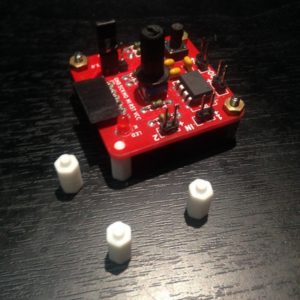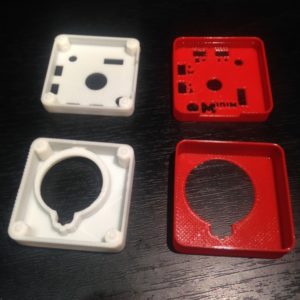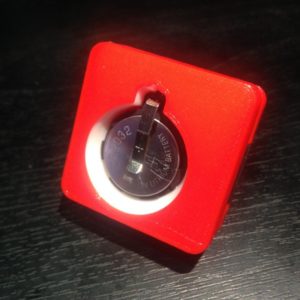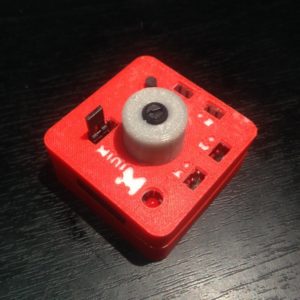I have just uploaded to the repository the files for the PCB model’s case, so I think this is a good time to do a recap on the parts available.
Parts for miniMO without case
For the legs I often use spacers with brass nuts, but I have also made a 3d model that stays in place without nuts:
The modules are very light, so I designed connector parts to keep them from moving:
Finally, to prevent the legs from rotating when several modules are connected, I designed a part that locks them in place:
miniMO case
The case consists of four parts, two for each side (scaffolding and shell).
I designed the lower part around the battery on purpose, so replacing batteries is a snap.
There are several reasons for having two parts:
- Using contrasting colors, it is possible to show text or signs as cutouts in the outer shell. This looks pretty, and the parts are easy to print
- A two-part design allows for using different materials. That way, you can use expensive filament on the outer shell only, or print the shell in a material with different properties (elastic, for instance)
- The scaffolding part is prone to be revised for structure 1, while the outer shell will most likely be revised for appeal. Either way, there’s no need to reprint the whole set, thus saving on time and materials
After many tests, my choice of materials is PLA for the scaffolding and Filaflex2 for the shell:
- Filaflex is a flexible material, so it is forgiving on minute size variations in a two-part case
- Shells made with this material stay in place but are very easy to remove. Changing shells takes a few seconds and needs no tools
- It has a nice finish, and the base grips to the surface it’s on
This is not to say you can’t print both parts in PLA; I have printed them myself using PLA from several shops and in several colors3.
Knob Cover
The knob cover is a simple design that surrounds the potentiometer shaft. The shaft has an arrow engraved, so this design allows you to see where the knob is pointing at without having to add notches to the part. Also, since it exposes the shaft, it opens the door to using shafts of different colors.
I’ve made two versions, one for PLA and another for Filaflex. The latter has a tighter grip to compensate for the material’s flexibility.
- Currently, the scaffolding parts feature legs that snap in place without screws; I might revise them in the future to use screws instead, depending on my experience and others’ feedback
- Since no two flexible filaments are the same, I thought it would be useful that I gave the name
- The biggest issue I’ve had so far is that the final dimensions depend a bit on the color, and since the parts snap one inside the other, some combinations have a tighter fit than others





